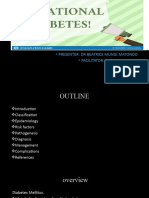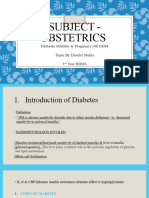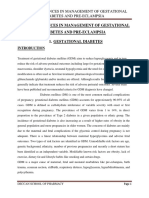Document
Document
Uploaded by
Asri RachmawatiCopyright:
Available Formats
Document
Document
Uploaded by
Asri RachmawatiOriginal Description:
Copyright
Available Formats
Share this document
Did you find this document useful?
Is this content inappropriate?
Copyright:
Available Formats
Document
Document
Uploaded by
Asri RachmawatiCopyright:
Available Formats
Care Process Model
JUNE
2013
GUIDELINES FOR MANAGEMENT OF
Neonatal Hypoglycemia
2013 update
These guidelines were prepared by Larry Eggert, MD, in consultation with
Intermountain Healthcares (Intermountains) Well Newborn Development Team
and NICU Development Team, under the guidance of Intermountains Women
and Newborns Clinical Program. The guidelines are derived from analysis of the
literature and expert consensus.
THE PROBLEM
Hypoglycemia in the newborn is not a medical condition in itself, but can be a
symptom of underlying disease. Prolonged or recurrent low glucose levels may lead
to long-term neurodevelopmental sequelae.
Unfortunately, the exact parameters of normal blood glucose in the neonate remain
controversial. Although neonates have a lower normal blood glucose range than
older infants, a blood glucose level that requires intervention in every newborn has
not been defined and appears to be dependent on birth weight, gestational age,
feeding method, and postnatal age in hours. Also uncertain are the level and duration
of hypoglycemia that cause damage and the vulnerability, or lack thereof, of the
brains of infants of differing gestational ages.
Because of the lack of clear definition of safe neonatal blood glucose levels, knowing
when and how to screen and intervene can be difficult. Based on analysis of the
literature, clinical experiences, and expert consensus, these guidelines promote a
pragmatic approach that provides a wide safety margin.
GENERAL RECOMMENDATIONS
The following are generally recommended principles; detailed recommendations
are given in the algorithm on page 2 of this document.
1 Initiate feeding. Feeding should be initiated for all neonates as soon as the
infant is ready, preferably within 1 hour of birth. Neonates who are not fed
will have a physiologic drop in blood glucose, with a low at 1 to 1.5 hours of
age. The feeding should be breast milk (colostrum) or infant formula NOT
dextrose-water. Colostrum, if available, is preferred to formula.
2 Assess risk factors and symptoms. All neonates with risk factors or major
symptoms should have blood glucose checked.
3 Screen and manage based on initial feeding and assessment. If the
neonate is symptomatic or blood glucose level is less than 45 mg/dL, notify a
LIP while proceeding with management steps outlined in the algorithm on page 2.
New in the 2013 update:
Based upon input from our providers and nurses, our process algorithm now
addresses multiple pre-feeding glucose results less than 45 mg/dL in the
first 24 hours of life and provides further direction to manage consecutive
or non-consecutive low glucoses in those newborns.
The problem . . . . . . . . . . . . . . . . . . . . . . . . . . . . . . .1
General recommendations . . . . . . . . . . . . . . . 1
References . . . . . . . . . . . . . . . . . . . . . . . . . . . . . . . 1
ALGORITHM . . . . . . . . . . . . . . . . . . . . . . . . . . . . . . . 2
R EFE R EN C ES
1. Canadian Paediatric Society. Screening guidelines
for newborns at risk for low blood glucose. Paediatr
Child Health. 2004;9(10):723-729. http://www.cps.
ca/english/statements/fn/fn04-01.htm. Accessed
March 28, 2012.
2. Chan SW. Neonatal hypoglycemia. UpToDate Online.
Waltham, MA: 2010. http://www.utdol.com/online/
content/topic.do?topicKey=neonatol/5898&select
edTitle=1%7E38&source=search_result. Accessed
March 28, 2012.
3. Cornblath M, Hawdon, JM, Williams AF, et al.
Controversies regarding definition of neonatal
hypoglycemia: suggested operational thresholds.
Pediatrics [serial online]. 2000;105(5):1141-1145.
http://pediatrics.aappublications.org/cgi/content/
full/105/5/1141?ck=nck. Accessed March 28, 2012.
4. New Zealand Ministry of Health. Auckland District
Health Board. Newborn Services Clinical Guideline.
Guidelines for the Management of Hypoglycaemia.
2004 July. http://www.adhb.govt.nz/newborn/
guidelines/nutrition/HypoglycaemiaManagement.
htm. Accessed March 28, 2012.
5. Newborn Nursery QI Committee. Neonatal
hypoglycemia: initial and follow up management.
Portland (ME): The Barbara Bush Childrens Hospital
at Maine Medical Center; 2004 Jul. http://www.
guideline.gov/summary/summary.aspx?ss=15&doc_
id=7180&nbr=4293. Accessed March 28, 2012.
6. Volpe JJ. Neurology of the Newborn. 5th ed.
Pennsylvania, PA: Saunders/Elsevier; 2008.
7. Wight N, Marinelli KA, Academy of Breastfeeding
Medicine Protocol Committee. ABM clinical protocol
#1: guidelines for glucose monitoring and treatment
of hypoglycemia in breastfed neonates. Breastfeed
Med. 2006;1(3):178-184. http://www.guideline.gov/
summary/summary.aspx?doc_id=11218&nbr=0058
65&string=neonatal+AND+hypoglycemia. Updated
January 25, 2010. Accessed March 28, 2012.
8. World Health Organization. Hypoglycaemia of
the Newborn, Review of the Literature: 1997.
http://www.who.int/maternal_child_adolescent/
documents/chd_97_1/en/index.html. Accessed
March 28, 2012.
G U I D E L I N E S F O R M A N A G E M E N T O F N E O N ATA L H Y P O G LY C E M I A
J U N E 2013
ALGORITHM: MANAGEMENT OF NEONATAL HYPOGLYCEMIA
1 Initiate feeding for all neonates as soon as infant is ready, preferably within 1 hour of birth.
Feed breast milk/colostrum or infant formulaNOT dextrose-water. Colostrum, if available, is preferred to formula.
2 Assess the neonate for presence of the following risk factors and symptoms.
Risk factors:
Symptoms:
Prematurity or LBW (<2500 gm)
SGA or IUGR
Intrapartum asphyxia
Infant of a diabetic mother (IDM)
Macrosomic infant
Discordant twin (smaller)
Erythroblastosis fetalis
Polycythemia
Cold stress or
hypothermia
Asymptomatic
WITHOUT risk factors
No further action
necessary
Respiratory distress or
suspected sepsis
Microphallus or midline defect
Maternal terbutaline, propranolol, or
oral hypoglycemic agent during L&D
Asymptomatic
WITH risk factors
Symptomatic
Check blood glucose at least 30 minutes after conclusion of feeding,
but no later than 4 hours of age. (If baby wasnt interested in feeding
right after birth, check blood glucose within 2-3 hours after birth.)
Glucose >45
Some at-risk babies may
develop late hypoglycemia,
often between 12 and 24
hours of age. Follow clinically
and recheck glucose about
every 6 hours, before feeding,
for the first 24 hours of life.
If glucose remains <45, notify
LIP to request Neonatology
consult. Discuss further therapy
and discuss transport/transfer to a
higher-level neonatal unit.
Glucose 30 - 45
Recheck glucose 30 minutes after
conclusion of feeding
Glucose 45?
Check blood glucose immediately.
Glucose <30
Breastfeed, or feed expressed
breast milk or formula (10 ml/kg)
by mouth or gavage.
yes
Continue feeding.
Monitor glucose before feeding
until stable (>45 x 2).
Follow clinically and recheck
glucose about every 6 hours,
before feeding, for the first 24
hours of life.
Major symptoms: stupor, jitteriness, irritability,
high-pitched cry, seizures, apnea, cyanosis,
irregular rapid breathing, hypotonia
May be seen: hypothermia, temperature
instability, and/or poor suck or refusal to feed
Glucose 45
Notify LIP while proceeding with algorithm.
Retest glucose at bedside using Nova StatStrip
(venipuncture) or i-STAT (heel-stick or venipuncture); send
for STAT lab glucose only if bedside retesting cant be
done as described. If glucose is >45, return to appropriate
box above. Otherwise, proceed with algorithm.
Notify LIP.
Search for
other etiology.
Give minibolus D10W @ 2 ml/kg IV push
Then start D10W @ 80 ml/kg/day
no
Recheck glucose in
no more than 30 minutes
IF in the first 24 hours
2 consecutive glucose readings
before feeding are <45
or
3 non-consecutive glucose
readings before feeding are <45,
return to box indicated above.
Continue IV and wean as
tolerated.
After stopping IV, recheck glucose
before feedings until stable
(>45 x 2).
Follow clinically and recheck
glucose before feeding, as needed,
for the first 24 hours of life.
Glucose <45
Glucose 45?
yes
Repeat minibolus D10W @ 2 ml/kg IV push
Increase rate of D10W to 100 ml/kg/day
For glucose <30, now or later, notify LIP
to request STAT Neonatology consult.
Recheck glucose in no
more than 30 minutes
no
yes
Once glucose is >45,
screen every 1-2 hours
until stable (>45 x 2)
Glucose 45?
no
Repeat minibolus D10W @ 2 ml/kg IV push
no
Symptoms?
Increase rate of D10W to 120 ml/kg/day
Recheck glucose in no
more than 30 minutes
yes
Notify LIP. Search for
other etiology.
yes
Glucose 45?
no
2010-2013 INTERMOUNTAIN HEALTHCARE. ALL RIGHTS RESERVED. PATIENT AND PROVIDER PUBLICATIONS 801-442-2963 CPM011 - 06/13
page 2 of 2
You might also like
- 1992-The Plains of San Agustin Controversy (CUFOS)Document90 pages1992-The Plains of San Agustin Controversy (CUFOS)Kimo12No ratings yet
- Neonatal Hypoglycemia September 2022Document30 pagesNeonatal Hypoglycemia September 2022f.abraham50% (2)
- KISSES FROM KATIE by Katie Davis - Read Chapter 1Document15 pagesKISSES FROM KATIE by Katie Davis - Read Chapter 1Simon and Schuster40% (5)
- Gestational Diabetes Case Study With Questions For The Undergraduate NurseDocument46 pagesGestational Diabetes Case Study With Questions For The Undergraduate NurseAndrea Donmyer100% (1)
- Naplex Complete Study Outline A Topic-Wise Approach DiabetesFrom EverandNaplex Complete Study Outline A Topic-Wise Approach DiabetesRating: 4 out of 5 stars4/5 (3)
- 1Document2 pages1Tanya OrdoñezNo ratings yet
- Neonatal Hypoglycemia PaperDocument22 pagesNeonatal Hypoglycemia PaperhenryrchouinardNo ratings yet
- DR - Salika Jayasundara (MO/SCBU) General Hospital - Kegalle Sri LankaDocument23 pagesDR - Salika Jayasundara (MO/SCBU) General Hospital - Kegalle Sri LankaAli FalihNo ratings yet
- Neonatal Hypoglycemia: Do We Know What To Do?: Journal of Pediatrics and Neonatal CareDocument2 pagesNeonatal Hypoglycemia: Do We Know What To Do?: Journal of Pediatrics and Neonatal CareGita KurniasariNo ratings yet
- Management of Neonatal HypoglycemiaDocument14 pagesManagement of Neonatal Hypoglycemiaece142No ratings yet
- IDMDocument6 pagesIDMElisya KharuniawatiNo ratings yet
- Neonatal HypoglycemiaDocument14 pagesNeonatal HypoglycemiaAkankshaNo ratings yet
- Group 5 Endocrine and Metabolic Complications of The Newborn SU 6.5Document13 pagesGroup 5 Endocrine and Metabolic Complications of The Newborn SU 6.5CHARLOTTE DU PREEZNo ratings yet
- HypoglycaemiaDocument3 pagesHypoglycaemiaAneejaa BidhaNo ratings yet
- High Risk Nb.Document65 pagesHigh Risk Nb.Padmashree MannemNo ratings yet
- Aap Hipoglucemia 2011Document7 pagesAap Hipoglucemia 2011Cristhian BastidasNo ratings yet
- Hypoglycemia in The Newborn: AIIMS-NICU Protocols 2010Document13 pagesHypoglycemia in The Newborn: AIIMS-NICU Protocols 2010abhivnairNo ratings yet
- New Hypoglycmemia 1Document61 pagesNew Hypoglycmemia 1Suravi DuttaNo ratings yet
- India Journal of Pediatrics HypoglicemiaDocument6 pagesIndia Journal of Pediatrics HypoglicemiaJermaine Marlon RVNo ratings yet
- Medip, IJCP-1336 ODocument7 pagesMedip, IJCP-1336 OAvianitaNo ratings yet
- Mendiola-Neonatal Hypoglycemia PPT 1Document49 pagesMendiola-Neonatal Hypoglycemia PPT 1Maysa Ismail100% (1)
- 2019 Pathogenesis, Screening, and Diagnosis of Neonatal Hypoglycemia - UpToDateDocument14 pages2019 Pathogenesis, Screening, and Diagnosis of Neonatal Hypoglycemia - UpToDateSheyla Paola Alegre ParionaNo ratings yet
- Hypoglycemia ManagementDocument8 pagesHypoglycemia Managementkarolinareyes5312No ratings yet
- Gestational Diabetes: Dr. Oyeyiola Oyebode Registrar Obstetrics and Gynaecology Ola Catholic Hospital, Oluyoro IbadanDocument40 pagesGestational Diabetes: Dr. Oyeyiola Oyebode Registrar Obstetrics and Gynaecology Ola Catholic Hospital, Oluyoro Ibadanoyebode oyeyiolaNo ratings yet
- Neonatal Hypoglycemia ScriptDocument5 pagesNeonatal Hypoglycemia ScriptGita KurniasariNo ratings yet
- Hypoglycaemia Infant Management1Document10 pagesHypoglycaemia Infant Management1Nirubhana ArunthavasothyNo ratings yet
- Pediatrics Muy BuenoDocument7 pagesPediatrics Muy BuenoJoseChavezNo ratings yet
- Pathogenesis, Screening, and Diagnosis of Neonatal HypoglycemiaDocument22 pagesPathogenesis, Screening, and Diagnosis of Neonatal Hypoglycemiamayteveronica1000No ratings yet
- Diabetes in PregnencyDocument51 pagesDiabetes in PregnencyMuneeb JanNo ratings yet
- Hypoglycaemia in Healthy Term NewbornsDocument5 pagesHypoglycaemia in Healthy Term NewbornsYwagar YwagarNo ratings yet
- Treatment of Diabetes in Women Who Are Pregnant: Pharmacist'S Letter / Prescriber'S LetterDocument5 pagesTreatment of Diabetes in Women Who Are Pregnant: Pharmacist'S Letter / Prescriber'S Lettercarramrod2No ratings yet
- Gestational Diabetes Mellitus (GDM) .TriceDocument47 pagesGestational Diabetes Mellitus (GDM) .TricejerrydanfordfxNo ratings yet
- Diabetes Mellitus & Pregnancy by D.a.mehtaDocument31 pagesDiabetes Mellitus & Pregnancy by D.a.mehtadr.d.a.mehta11No ratings yet
- Recent Advances in Management of Gestational Diabetes and Pre-EclampsiaDocument36 pagesRecent Advances in Management of Gestational Diabetes and Pre-EclampsiaSyed Zahed AliNo ratings yet
- لقطة شاشة ٢٠٢٤-٠٢-٢٦ في ٣.٠٨.٢٩ مDocument32 pagesلقطة شاشة ٢٠٢٤-٠٢-٢٦ في ٣.٠٨.٢٩ مali1alio11aaNo ratings yet
- Approach To Hypoglycemia in Infants and Children - UpToDateDocument31 pagesApproach To Hypoglycemia in Infants and Children - UpToDateyohanes gabriel dwirianto w.aNo ratings yet
- Neonatal HypoglyDocument31 pagesNeonatal HypoglyAli FalihNo ratings yet
- MCN 2Document7 pagesMCN 2leniebelpactaoNo ratings yet
- Management and Outcome of Neonatal HypoglycemiaDocument22 pagesManagement and Outcome of Neonatal HypoglycemiaMejía Andrés HaroldNo ratings yet
- Hypocalcemia Is A Laboratory and Clinical Abnormality That Is Observed With Relative FrequencyDocument3 pagesHypocalcemia Is A Laboratory and Clinical Abnormality That Is Observed With Relative FrequencySuzetteBragaSamuelaNo ratings yet
- Diabetes in PregnancyDocument11 pagesDiabetes in PregnancyAlana CaballeroNo ratings yet
- HypoglycemiaDocument2 pagesHypoglycemiasourav deyNo ratings yet
- Neonatal HypoglycemiaDocument5 pagesNeonatal Hypoglycemiadiana rossNo ratings yet
- Gestational Diabetes MellitusDocument47 pagesGestational Diabetes MellitusHasan A AsFourNo ratings yet
- Neonatal Hypoglycemia - American Academy of PediatricsDocument7 pagesNeonatal Hypoglycemia - American Academy of PediatricsAlienNo ratings yet
- DIABETES MELLITUS IN PREGNANCY - PPTX CUIXLEXDocument61 pagesDIABETES MELLITUS IN PREGNANCY - PPTX CUIXLEXh27nkhhtw4No ratings yet
- Presentación - Alteraciones MetabólicasDocument29 pagesPresentación - Alteraciones MetabólicasJuan Jose LosadaNo ratings yet
- Neonatal HypoglycaemiaDocument29 pagesNeonatal HypoglycaemiarhylesmartNo ratings yet
- Oke MantapDocument7 pagesOke MantapMuhammad FadhilNo ratings yet
- Gestational Diabetes MellitusDocument31 pagesGestational Diabetes MellitusJasmine PraveenNo ratings yet
- Neonatal Glucose Metabolism Differential Diagnoses, Evaluation, and Treatment of Hypoglycemia 2002Document11 pagesNeonatal Glucose Metabolism Differential Diagnoses, Evaluation, and Treatment of Hypoglycemia 2002Guillermo CalderaroNo ratings yet
- Diabetes Mellitus in PregnancyDocument26 pagesDiabetes Mellitus in Pregnancymokeiramarion74No ratings yet
- Seminar 5 - DM in PregnancyDocument19 pagesSeminar 5 - DM in PregnancyHakimah K. SuhaimiNo ratings yet
- Endocrinology ReferralDocument3 pagesEndocrinology Referralioana.gl0496No ratings yet
- Neonatal Problem 2Document28 pagesNeonatal Problem 2Nabilah NajlaaNo ratings yet
- Diagnosis and Treatment of Hyperglycemia in PregnancyDocument25 pagesDiagnosis and Treatment of Hyperglycemia in PregnancyTaufiqurrokhman RofiiNo ratings yet
- GDM PresetationDocument26 pagesGDM PresetationYondri Mandaku TasidjawaNo ratings yet
- 2019 Management and Outcome of Neonatal Hypoglycemia - UpToDateDocument23 pages2019 Management and Outcome of Neonatal Hypoglycemia - UpToDateSheyla Paola Alegre ParionaNo ratings yet
- Diabetes Mellitus & Pregnancy: G.M PunarbawaDocument27 pagesDiabetes Mellitus & Pregnancy: G.M PunarbawaMartina RizkiNo ratings yet
- Management and Outcome of Neonatal HypoglycemiaDocument13 pagesManagement and Outcome of Neonatal HypoglycemiaCristina Fernández ValenciaNo ratings yet
- Hypoglycemia, A Simple Guide To The Condition, Treatment And Related ConditionsFrom EverandHypoglycemia, A Simple Guide To The Condition, Treatment And Related ConditionsNo ratings yet
- Diabetes Ready Reference for Nurse Practitioners: Clear, Concise Guidelines for Effective Patient CareFrom EverandDiabetes Ready Reference for Nurse Practitioners: Clear, Concise Guidelines for Effective Patient CareNo ratings yet
- Toilet Training: Methods, Parental Expectations and Associated DysfunctionsDocument9 pagesToilet Training: Methods, Parental Expectations and Associated DysfunctionsAsri RachmawatiNo ratings yet
- Icd X NeonatologiDocument2 pagesIcd X NeonatologiAsri RachmawatiNo ratings yet
- Helicobacter Pylori: A Review of Diagnosis, Treatment, and Methods To Detect EradicationDocument13 pagesHelicobacter Pylori: A Review of Diagnosis, Treatment, and Methods To Detect EradicationAsri RachmawatiNo ratings yet
- Helicobacter Pylori Stool Antigen TestDocument4 pagesHelicobacter Pylori Stool Antigen TestAsri RachmawatiNo ratings yet
- Helicobacter Pylori: A Review of Diagnosis, Treatment, and Methods To Detect EradicationDocument13 pagesHelicobacter Pylori: A Review of Diagnosis, Treatment, and Methods To Detect EradicationAsri RachmawatiNo ratings yet
- Stool Antigen Tests in The Diagnosis of Infection Before and After Eradication TherapyDocument5 pagesStool Antigen Tests in The Diagnosis of Infection Before and After Eradication TherapyAsri RachmawatiNo ratings yet
- Sclerema NeonatorumDocument8 pagesSclerema NeonatorumAsri RachmawatiNo ratings yet
- Oamjms 2015 062Document4 pagesOamjms 2015 062Asri RachmawatiNo ratings yet
- Tuberculosis: Challenging The Gold Rifampin Drug Resistance Tests ForDocument9 pagesTuberculosis: Challenging The Gold Rifampin Drug Resistance Tests ForAsri RachmawatiNo ratings yet
- Interpreting AV (Heart) Blocks: Breaking Down The Mystery: 2 Contact HoursDocument29 pagesInterpreting AV (Heart) Blocks: Breaking Down The Mystery: 2 Contact HoursAsri RachmawatiNo ratings yet
- Articles: BackgroundDocument6 pagesArticles: BackgroundAsri RachmawatiNo ratings yet
- 86 FullDocument8 pages86 FullAsri RachmawatiNo ratings yet
- Disruptions Result From Destruction of A NorDocument6 pagesDisruptions Result From Destruction of A NorAsri RachmawatiNo ratings yet
- Efficacy of Single-Dose Intravenous Immunoglobulin Administration For Severe Sepsis and Septic ShockDocument7 pagesEfficacy of Single-Dose Intravenous Immunoglobulin Administration For Severe Sepsis and Septic ShockAsri RachmawatiNo ratings yet
- Celulas Madres Cerebro HIDocument10 pagesCelulas Madres Cerebro HIAsri RachmawatiNo ratings yet
- Think & Grow RichDocument14 pagesThink & Grow RichUtkarsh PriyadarshiNo ratings yet
- CHED Tracer SurveyDocument8 pagesCHED Tracer SurveySharmi Joyce DausenNo ratings yet
- Diploma Projects 2018-2019Document4 pagesDiploma Projects 2018-2019RamsathayaNo ratings yet
- Configure and Apply Accrual Schemes - Learn - Microsoft DocsDocument4 pagesConfigure and Apply Accrual Schemes - Learn - Microsoft DocsAndrew PackNo ratings yet
- 7 Recognition Ceremony: Philippine-Emirates Private School Abu Dhabi, United Arab EmiratesDocument16 pages7 Recognition Ceremony: Philippine-Emirates Private School Abu Dhabi, United Arab EmiratesMeejinMendozaCariagaNo ratings yet
- Gunpowder Artillery in The Song Dynasty: From Wikipedia, The Free EncyclopediaDocument3 pagesGunpowder Artillery in The Song Dynasty: From Wikipedia, The Free EncyclopediaKenneth Lee100% (1)
- สำเนา Price Quotation Template Excel Free DownloadDocument5 pagesสำเนา Price Quotation Template Excel Free DownloadenteNo ratings yet
- DefinitionsDocument4 pagesDefinitionsyofaceNo ratings yet
- Assessment Explanation of The Problem Objectives Nursing Interventions Rationale Subjective: Objective: Sto: DXDocument2 pagesAssessment Explanation of The Problem Objectives Nursing Interventions Rationale Subjective: Objective: Sto: DXJohn Ford VisoriaNo ratings yet
- 210625 - LS 초전도 웹용 - En - 8pDocument5 pages210625 - LS 초전도 웹용 - En - 8p최경현No ratings yet
- Yu Tek & Co. v. GonzalesDocument7 pagesYu Tek & Co. v. GonzalesDavid Anthony PadreNo ratings yet
- Unilateral Deed of Absolute SaleDocument2 pagesUnilateral Deed of Absolute SaleMichie BeeNo ratings yet
- RFBT - MasterDocument7 pagesRFBT - MasterLizza Marie Casidsid100% (1)
- Untitled StoryDocument17 pagesUntitled StoryJas CalzadoNo ratings yet
- Jurnal Tesis 25Document15 pagesJurnal Tesis 25Fadel KurniawanNo ratings yet
- John Fowles Final (5p)Document5 pagesJohn Fowles Final (5p)Laura UngureanuNo ratings yet
- 5 QuestionnerDocument6 pages5 QuestionnerKirupanandan NithyaaNo ratings yet
- Famous Machiavelli Quotes - Philosophy ParadiseDocument6 pagesFamous Machiavelli Quotes - Philosophy ParadisesickwidowNo ratings yet
- Komatsu Hydraulic Excavator Pc850se 8 Shop ManualDocument20 pagesKomatsu Hydraulic Excavator Pc850se 8 Shop Manualleon100% (56)
- Laceration Repair: A Practical Approach: Randall T. Forsch, MD, MPH Sahoko H. Little, MD, PHD and Christa Williams, MDDocument10 pagesLaceration Repair: A Practical Approach: Randall T. Forsch, MD, MPH Sahoko H. Little, MD, PHD and Christa Williams, MDLeonardoCampanelliNo ratings yet
- Thematic Map - Wikipedia, The Free EncyclopediaDocument5 pagesThematic Map - Wikipedia, The Free EncyclopediaAnthony AngelesNo ratings yet
- Significant Statements Audit Trail Formulated Meaning Themes KI1 KI2 KI3 KI4 KI6 KI7Document6 pagesSignificant Statements Audit Trail Formulated Meaning Themes KI1 KI2 KI3 KI4 KI6 KI7JaymarkCasasNo ratings yet
- Seminar Report On BankingDocument14 pagesSeminar Report On BankingMohan Rao100% (1)
- Burk v. Ottawa GasDocument1 pageBurk v. Ottawa GasjustinegalangNo ratings yet
- A Hundred Dresses Part 1 PDFDocument34 pagesA Hundred Dresses Part 1 PDFArnav Singhal100% (1)
- Cel de Al Treilea Ochi, Horus, Glanda Pineala Si Ovarul IncoltitDocument9 pagesCel de Al Treilea Ochi, Horus, Glanda Pineala Si Ovarul IncoltitluizetteNo ratings yet
- Stop Googling. Let's Talk - The New York TimesDocument5 pagesStop Googling. Let's Talk - The New York Timessonusingh7867No ratings yet
- Newsletter December 2014Document10 pagesNewsletter December 2014api-242081048No ratings yet







































































































